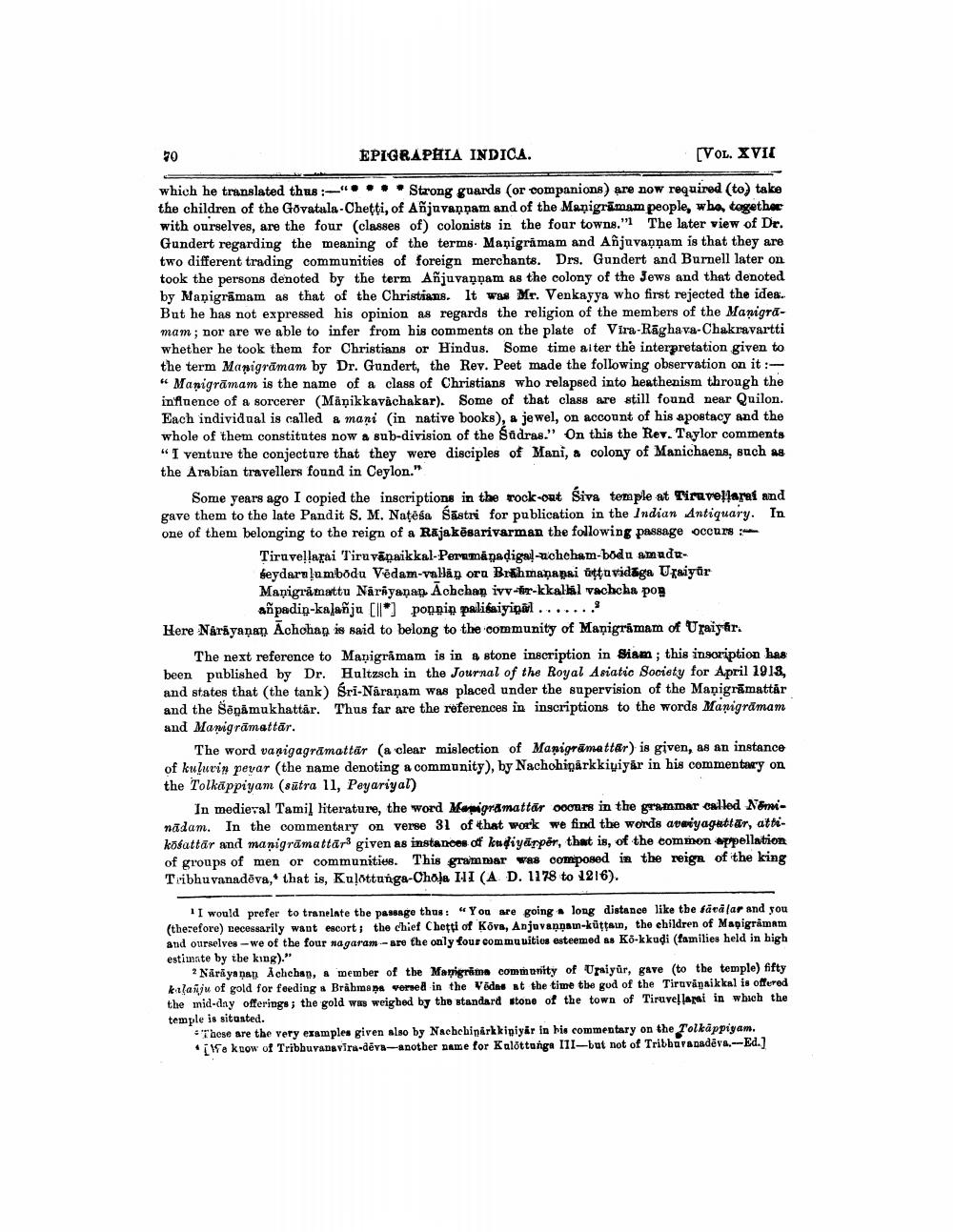________________
70
EPIGRAPHIA INDICA.
[VOL. XVII
which he translated thus:Strong guards (or companions) are now required (to) take the children of the Govatala-Chetti, of Añjuvannam and of the Manigramam people, who, together with ourselves, are the four (classes of) colonists in the four towns." The later view of Dr. Gundert regarding the meaning of the terms. Manigramam and Añjuvappam is that they are two different trading communities of foreign merchants. Drs. Gundert and Burnell later on took the persons denoted by the term Añjuvannam as the colony of the Jews and that denoted by Manigramam as that of the Christians. It was Mr. Venkayya who first rejected the idea. But he has not expressed his opinion as regards the religion of the members of the Manigramam; nor are we able to infer from his comments on the plate of Vira-Raghava-Chakravartti whether he took them for Christians or Hindus. Some time aiter the interpretation given to the term Manigramam by Dr. Gundert, the Rev. Peet made the following observation on it :"Manigramam is the name of a class of Christians who relapsed into heathenism through the influence of a sorcerer (Mäņikkavachakar). Some of that class are still found near Quilon. Each individual is called a mani (in native books), a jewel, on account of his apostacy and the whole of them constitutes now a sub-division of the Sudras." On this the Rev. Taylor comments "I venture the conjecture that they were disciples of Mani, a colony of Manichaens, such as the Arabian travellers found in Ceylon."
Some years ago I copied the inscriptions in the rock-out Siva temple at Tiruvellarai and gave them to the late Pandit S. M. Națesa Sastri for publication in the Indian Antiquary. In one of them belonging to the reign of a Rajakesarivarman the following passage occurs
Tiruvellagai Tiruvapaikkal-Peramanadigal-achcham-bodu amuduseydaralumbodu Vēdam-vallan ora Brahmananai üṭṭuvidaga Uraiyür Manigramattu Narayanan Achchan ivv-ir-kkallal vachcha pon añpadin-kajanju [*] ponnin palisaiyinal.......
Here Narayanan Achchan is said to belong to the community of Manigramam of Uraiyfir.
The next reference to Manigramam is in a stone inscription in Siam; this inscription has been published by Dr. Hultzsch in the Journal of the Royal Asiatic Society for April 1913, and states that (the tank) Śri-Naranam was placed under the supervision of the Manigrāmattār and the Sepämukhattar. Thus far are the references in inscriptions to the words Manigramam and Manigramattar.
The word vanigagramattar (a clear mislection of Manigramattar) is given, as an instance of kuluvin pevar (the name denoting a community), by Nachchinärkkipiyar in his commentary on the Tolkappiyam (sutra 11, Peyariyal)
In medieval Tamil literature, the word Manigramattar occurs in the grammar called Neminadam. In the commentary on verse 31 of that work we find the words avaiyagattar, attikosattar and manigramattars given as instances of kudiyarper, that is, of the common appellation of groups of men or communities. This grammar was composed in the reign of the king Tribhuvanadeva, that is, Kulottunga-Chola III (A D. 1178 to 1216).
I would prefer to tranelate the passage thus: "You are going a long distance like the fävälar and you (therefore) necessarily want escort; the chief Chetti of Kova, Anjuvannam-küttain, the children of Manigramam and ourselves-we of the four nagaram-are the only four commuuities esteemed as Kō-kkudi (families held in high estimate by the king)."
2 Narayanan Achchan, a member of the Manigrama community of Uraiyür, gave (to the temple) fifty kalanju of gold for feeding a Brahmana versed in the Vedas at the time the god of the Tiruvanaikkal is offered the mid-day offerings; the gold was weighed by the standard stone of the town of Tiruvellarai in which the temple is situated.
These are the very examples given also by Nachchiparkkipiyar in his commentary on the Tolkäppiyam.
4
[We know of Tribhuvanavīra-deva-another name for Kalottunga III-but not of Tribhuvanadeva.-Ed.]




